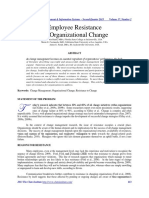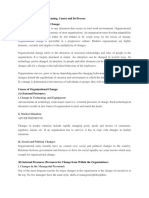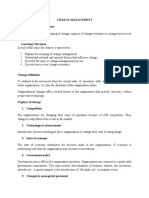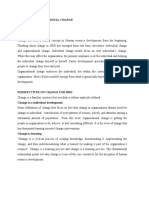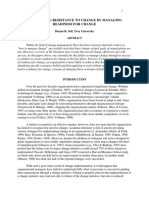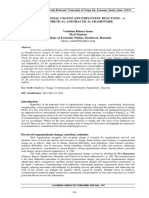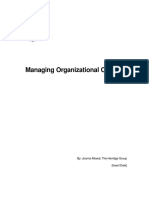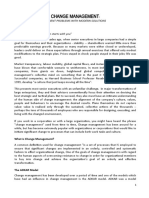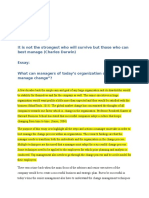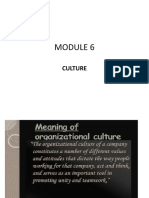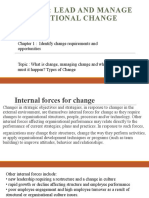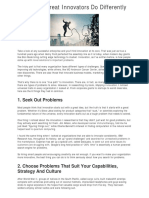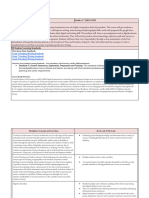BUILDING AND DEVELOPING THE CHANGE CAPACITY OF AN
ORGANISATION
Iuliana, Talmaciu1
Abstract
Regardless of their scale, organisational changes are, most often, unpredictable and worrisome.
However, organisations must find the most effective ways to adapt to the changes from the environment where
they operate.
This article presents the results of identifying and analysing the causes which are the main obstacles to the
change management. Based on the study, we identify and express measures for building and developing the change
capacity of an organisation. At the same time, we also identify the means by which the change capacity of an
organisation can be improved given the research conducted and the analysis of certain works from the literature.
Keywords: organisational change, change capacity, organisational change failure
JEL Classification: M10.
1. Introduction
Michael Jarrett, one of the most renowned specialists in the field of change
management, adds to the following very well known American saying: “change is like death
and tax – inevitable.” However, the author mentions, “we can choose every time how to
answer it: we can accept it or oppose it.” (2011: 23)
The idea of “change – inevitable phenomenon” is also found in Liz Clarke who believes
that “change is the very essence of developing a business ... It’s strange that we behave
stubbornly in acting according to the deceptive assumption that things will remain
unchanged.” (Clarke Liz, 2002: 18)
In the context of a dynamic economic and social environment, of the scientific and
technical progress and increased competitiveness, organisational change has become a subject
highly debated and analysed by the theorists and practitioners in the field.
Change management is a ubiquitous topic in the literature given that both specific
concepts and principles are increasingly integrated in other subjects. (Marge Combe, 2014)
Nevertheless, the failure rate of the organisational change implementation remains high.
Experts have identified several causes for this, including: bureaucracy, conservatism of the
organisational culture, leadership inefficiency or the organisation members’ resistance to
change. (Bennebroek Gravenhorst, Werkman and Boonstra: 2003)
The concept of change consists of “the significant change of a status, of a relationship or
of a situation in a political, economic and social context of the organisation, whose elements
affect the people working within it.” (Petrescu Marius et. all, 2010: 28)
Buono Anthony and Kerber Kenneth (2009) consider it important to distinguish between
the concept of “preparation for change”, which represents the ability to implement a specific
change, and the “change capacity”, which means the ability of an organisation to change not
just once, but as a normal course of events, as a response to anticipating the internal and
external changes.
In our opinion, no organisation can develop unless it wishes to be open to all that is
“new” and unless it succeeds in adapting itself. Therefore, a careful analysis of the change
capacity of an organisation should be made and then identify some tools for building and
developing it. We believe that this will lead to improving the efficiency of change
management as well.
11
PhD. Student, Valahia University of Târgovişte, iuliana_talmaciu@yahoo.com
76
� 2. The main causes of the failure to implement the organisational changes
“Organisations are faced with frequent changes in the market sphere, in the individual
preferences and in the socio-economic context. Therefore they must react quickly in order to
survive. Unfortunately, many of them fail to do this, the statistics showing that the average
lifespan of a company does not exceed 40 years; on the contrary it is reduced because of the
organisation’s inability to transform and adapt itself fast enough. For this reason, tackling
change has become an essential aspect of the competitive advantage.” (Clarke Liz, 2002: 12)
The research conducted by Scott Keller and Carolyn Aiken (2009) found that
approximately 70% of the attempts to implement organisational changes fail. The two authors
mention that the low rate of success of the change management is caused by two main
elements: the employees' attitude and the management’s behaviour. (McKinsey Quarterly
Report, April 2009)
The studies in the field conducted by Prosci Company (2012) identify five main
obstacles in the change management:
1. ineffective support from the leaders. Approximately 80% of the change initiatives
that have benefited from effective support from the leaders have met or even exceeded the
targets set. Among the problems identified in this area, we include:
- poor or conflicting involvement, low commitment towards change from the initiators
of the change process;
- lack of alignment between the objectives of the change process and the organisational
objectives, which creates confusion among employees;
- lack of authority from the initiators.
2. insufficient resources. The process of change is made difficult when the
organisation’s management does not really support the change initiative, and the human,
material, financial, etc. resources are insufficient or inadequate;
3. resistance to change from the employees, middle managers or top managers;
4. inefficient and weak communication.
The people’s reactions towards change in general and the organisations they are part of,
in particular, are marked both by positive and negative aspects. Among the positive aspects
we mention enthusiasm, challenge, acquiring new skills, enhancing knowledge and getting
rewards. Clarke Liz (2002)
The negative reactions towards change are usually marked by fear, mistrust, anger,
stress, disorientation, loss of the sense of belonging to a group, lack of concentration, conflict,
resistance, etc.
Among the causes of resistance to change from the employees we identified the following:
- the lack of understanding regarding the need for change;
- employees who are close to retirement or who do not want to learn something new;
- the feeling of insecurity when faced with change;
- unpleasant experiences related to previous change processes;
- employees involved in too many change initiatives.
The resistance to change from managers is caused by the following reasons:
- managers do not support the change initiative because they do not understand or do not
accept the need for change;
- insecurity when faced with change and the fear of losing control and/or the place of work;
- lack of knowledge and skills in the field of change management;
- lack of time to properly manage the change process;
- lack of confidence in themselves, based on negative experiences regarding the
implementation of previous changes.
Furthermore, clear, transparent and honest communication regarding the need and
impact of change is essential for the success of the initiative. In addition, the person who
77
�transmits messages must have sufficient authority in the organisation so that the
communication has the desired impact. It is important for the communication process to focus
more on the need to change and less on the details of the implementation, so that people do
not lose sight of the main objective during the implementation of the change process.
(www.manageranticriza.ro)
3. The need for building and developing an organisation’s capacity to change in the
current social-economic context
According to Michael Jarrett (2011: 19), “the great managerial challenge is not that of
understanding the need for change (this, though a crucial moment in the process of change, is
only the first step), but to make the actual change.”
Marge Combe (2014: 14) believes that in order to have positive results from the
implementation of the change management, sufficient attention must be paid to the question
"how could change management be effective if the organisation is not ready for change?.”
Why do some companies manage to successfully implement an impressive number of
change initiatives, while others fail in such projects? What is the difference between the
organisations that manage to implement the change and those who fail? We agree with the
experts’ opinion that the difference lies in the “change capacity” of the organisation. This
reflects the attitude and the essential internal capacities, as well as their dynamics, which
helps them adapt to the changes from the external environment.
The literature presents some models that try to assess how ready an organisation is for
change, but, as Weiner Bryan (2009: 29) said, “as opposed to preparing individuals for
change, that of the organisations has not yet been the subject of some in-depth theoretical
research or of empirical studies.”
Bennebroek Gravenhorst, Werkman and Boonstra (2003) consider that in order to assess
the change capacity of an organisation, six aspects should be considered: the objectives and
strategy of the organisation, the structure, the culture, the technology, the employment
characteristics and the power relations. Following their analysis one can identify the means by
which the change capacity of the organisation can be developed.
4. Means of improving the change capacity of an organisation
A certain resistance to change is inevitable and we consider it as being even welcome in
some cases, but we should consider measures for compensating it. At top management level
this can be achieved by increasing the level of understanding regarding the need for change
(or its foundation), the elaboration of its implementation plan and the analysis of the possible
results both on short and medium or long term.
At middle management level it is recommended to highlight the way in which change
affects the people in the organisation, direct and transparent communication with those
affected by the change and the involvement of the employees in the process of change.
Change management does not only involve implementing the change itself but it must
include actions that can achieve the organisation’s adaptation to change.
We consider that they should be carried out continuously and not be undertaken only
when the need for change has already been identified. The change capacity of an organisation
is built and developed over time and it requires the involvement of all its members. These
actions concern the following:
- adapting the organisational structure to the innovation elements introduced;
- rethinking the strategy from the new perspective of change;
- readapting the management systems of the organisation, namely the information
system, the decision making one, etc.
78
� - promoting a management style that not only fosters change, but also attracts the
members of the organisation towards change and towards expressing their creative potential;
- the action on the organisation's human resources from the perspective of improving
the qualification and re-qualification of the organisation’s members, rethinking their position
in the organisation, along with remodelling their behaviour (attachment, loyalty, promotion of
the organisation’s interests, etc);
- shaping new qualities of the organisation corresponding to the changes made and to
the ones to come;
- rethinking the system of values that must underpin the organisation's orientation
(production of clean goods, increase the quality of after-sales service, etc.).
Ovidiu Nicolescu and Ion Verboncu (2008: 345) consider that “in the current economic
environment, managers are increasingly faced with the issue of learning, of preparing for change.”
This involves the following:
- clarity of objectives at all levels of the organisation;
- planning the actions and involving the managers and specialists in resolving the
relevant issues;
- empowering employees to support the change initiatives;
- assessing the performance and providing certain answers;
- capitalising the ideas of the organisation’s entire staff;
- becoming aware of the fact that the change is a learning process.
The degree of attention towards the human resources involved in the change process
triggers the success or failure of the change initiatives.
The experts in change management propose a set of four conditions required for a
successful organisational change, considering the nature of the organisation’s human
resource, including its irrational and unpredictable dimensions (www.manageranticriza.ro,
April 2014)
• development of attractive incentives;
• providing a behavioural model;
• strengthening the change implementation and support mechanisms;
• building the organisational capacity for change.
The experts in change management and scholars have analysed some contextual
conditions affecting the organisational readiness for change (Weiner J Bryan, 2009). Jones
RA, Jimmieson NL, Griffiths A (2005) argue that an organisational culture that includes
innovation, risk-taking and learning supports the organisational readiness for change. They
also emphasise the importance of some flexible organisational policies, the role of the
organisational environment in promoting the organisational change and the previous positive
experience that can stimulate the willingness to support the organisational transformations.
5. Conclusions
The organisation that does not accept the change as an efficient and competitive process
will no longer be competitive; it will no longer be able to meet the new requirements of the
market and it will gradually lose its customers. The change can bring both improvements and
deterioration in the performance of an organisation, which is why determining the timing for
its initiation is one of the most important responsibilities of the managers. The role of
managers does not stop only at the stage of identifying the need for change and the timing for
starting the process of organisational change.
Since change means both threat and opportunity, the way in which the organisation’s
members perceive it is important and this is where the managers’ talent has an essential role
in paying attention in the long run to the attitudes and internal behaviours for developing the
change capacity of the organisation.
79
� The building and developing process of the change capacity of the organisation is a
multi-faceted one, on long-term, and it involves the use of some important resources and the
risk management. That is why we consider that one of the most important qualities of a
change manager is his/her capacity to take responsibility for the risk. Each organisational
change, regardless of its nature, is accompanied by a series of risks that must be understood
and assumed by all the members of the organisation, but especially by the managers.
The development of an organisation involves constant changes; therefore it also needs to increase its capacity
to adapt to the conditions dictated by the increasingly dynamic economic, social and political environment.
In our opinion, in order to be able to talk about developing the change capacity of an
organisation, more attention should also be given to the evaluation process of the change, in
order to analyse the way in which the measures required by the change have been
implemented, in order to identify the possible deviations from achieving the set objectives,
but also in order to identify new directions of developing the organisation.
Acknowledgement
This work was supported by the project “ Excellence academic routes in the doctoral and
postdoctoral research –READ” co-funded from the European Social Fund through the Development
of Human Resources Operational Programme 2007-2013, contract no. POSDRU/159/1.5/S/137926.
Bibliography:
1. Bennebroek Gravenhorst M. Kilian, Werkman A. Renate, Boonstra J. Jaap - The
Change Capacity of Organisations: General Assessment and Five Configurations, Applied
Psychology: an International Review, 52(1), 83 –105, 2003
2. Buono F. Anthony, Kerber W. Kenneth - Building organisational change, capacity,
Management Consulting Division International Conference, Vienna, Austria, 2009
3. Clarke Liz - Managementul schimbării – Ghid practic privind producerea,
menţinerea şi controlul schimbării într-o firmă sau organizaţie [Change Management -
Practical guide regarding the production, maintenance and control of change in a company
or organisation], Teora Publishing House, Bucharest, 2002
4. Combe Marge - Change readiness: focusing change management where it counts, Project
Institute Management, www.pmi.org/learning/~/media/PDF/Knowledge%20Center/Focusing-
Change-Management-Where-it-Counts.ashx, 2014
5. Jarrett Michael - Gata de schimbare – de ce unele companii se pot transforma cu
succes – iar altele nu [Ready for change – Why can some companies successfully transform –
and others can not], Publica Publishing House, Bucharest, 2011
6. Jones RA, Jimmieson NL, Griffiths A, The Impact of Organisational Culture and
Reshaping Capabilities on Change Implementation Success: The Mediating Role of Readiness
for Change, Journal of Management Studies, 2005
7. Gravenhorst Bennebroek M. Kilian, Werkman A. Renate, Boonstra J. Jaap, The
Change Capacity of Organisations: General Assessment and Five Configurations, Applied
Psychology: an international review, 52 (1), 83-105, 2003
8. Nicolescu Ovidiu; Verboncu Ion - Fundamentele managementului organizaţiei [The
fundamentals of organisational management], University Publishing House, Bucharest, 2008
9. Petrescu Marius, Stegăroiu Ion, Năbârjoiu Neculae, Duică Anişoara, Popa Eliza - Managementul
schimbării şi riscului [Change and Risk Management], Bibliotheca Publishing House, Târgovişte, 2010
10. Weiner J Bryan - A theory of organisational readiness for change,
http://www.implementationscience.com/content/4/1/67, 2009
11. ***Managementul schimbării – de ce eşuează iniţiativele de schimbare [Change
Management – Why do the change initiatives fail], www.manageranticriza.ro, aprilie 2014
12. ***www.prosci.com
80
